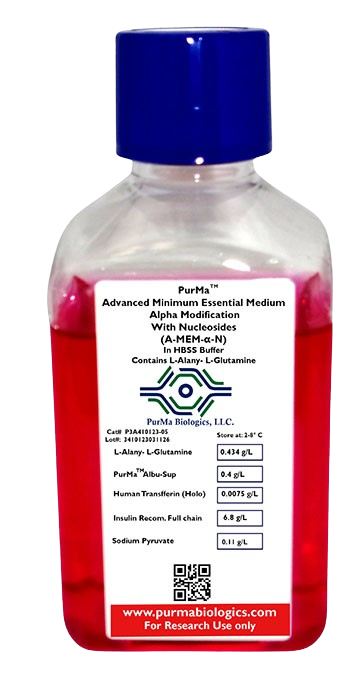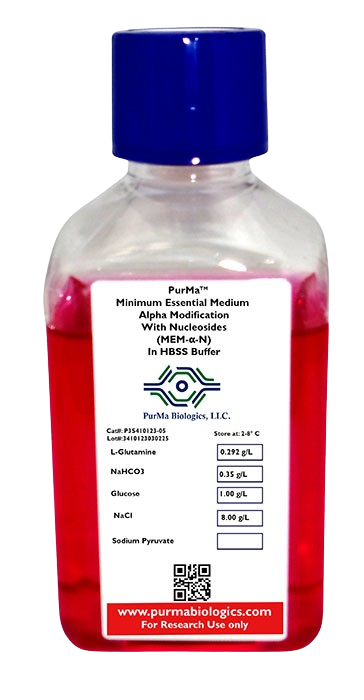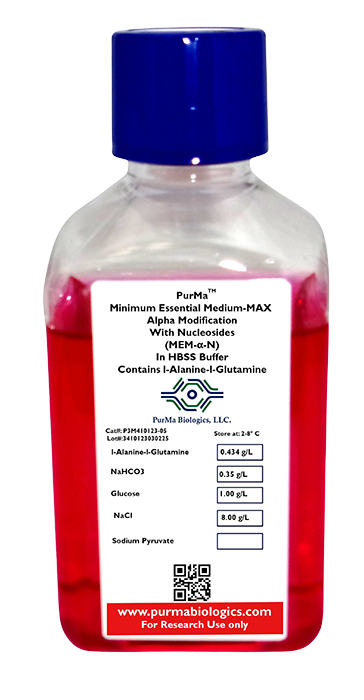MEM α-Modification with Nucleosides in Hanks’ Buffer
Background
MEM α-Modification with Nucleosides in Hanks’ buffer provides a great nutritional culture environment during mammalian cells. This media, as well plays a key role in the process of selection of transfected DHFR-negative cells. Moreover, MEM-α-N-HBSS is widely used for a variety of suspension and adherent cells. Calcium, however, plays a crucial role in media as eliminating this ion facilitates the growth of cells in suspension cultures.
Ingredients
MEM-α with nucleosides is basically the modified version of MEM-α and contains:
- Ribonucleosides
- Deoxyribonucleosides
- Non-essential amino acids.
- Sodium pyruvate.
- Lipoic acid.
- Vitamin B12.
- Biotin and,
- Ascorbic acid.
PurMa™ MEM-α-N-HBSS contains HBSS buffer
The composition of HBSS buffer:
- Potassium Chloride
- Potassium Phosphate, monobasic
- Sodium Bicarbonate
- Sodium Chloride
- Sodium Phosphate, dibasic
Additionally, MEM-α-N-HBSS also Contains:
- Low level of glucose (1.00 g/ liter)
- Sodium bicarbonate (0.35 g/L)
- 2 mM L-glutamine (292 mg/L)
PurMa Biologics manufactures 119 types of MEM-α-N-HBSS
Application
Furthermore, MEM-α-N-HBSS is used for various cell types such as keratinocytes, primary rat astrocytes, as well as human melanoma cells. also, MEM-α-N-HBSS has been used for the isolation of mesenchymal stem cells, adipose-derived stem cells, and osteoblasts. Moreover, MEM α-Modification is widely used for primary osteoblast cultures.
Formulation
For complete formulation click here as well as ” formulation Tab : MEM alpha with nucleoside in HBSS Buffer Formulation
References
- A previously functional tetracycline-regulated transactivator fails to target gene expression to the bone. Schmidt et al. BMC Res Notes. 2011 Aug 11;4:282. doi: 10.1186/1756-0500-4-282. PMID: 21835026.
-
- MEM α-Modification with Nucleosides in Hanks’ Buffer, Cell Culture Media
Advanced MEM-Alpha with Nucleosides in Hanks’ Buffer
- Advanced MEM-Alpha with Nucleosides in Hanks’ Buffer contains L-Alanyl-L-Glutamine as well as ingredients to allow for serum reduction. Additionally, A-MEM-α-N needs 2-5% FBS and provides more consistency.
- Read more
-
- Sale!
- MEM α-Modification with Nucleosides in Hanks’ Buffer, Cell Culture Media
MEM α-Modification with Nucleosides in Hanks’ Buffer
- $49.10 – $1143.83
- MEM α-Modification with Nucleosides in Hanks’ buffer provides a great nutritional culture environment for mammalian cells. this media as well plays a key role in the process of selection for transfected DHFR-negative cells.
- Select options
-
- MEM α-Modification with Nucleosides in Hanks’ Buffer, Cell Culture Media
MEM α-Modification with Nucleosides MAX (MEM-α-N-MAX) in Hanks’ Buffer
- MEM α-Modification with Nucleosides MAX in Hanks’ Buffer (MEM-α-N-MAX-HBSS) contains L-Alanyl-L-Glutamine, as well as Nucleosides. Additionally, MEM-α-N-MAX (HBSS) significantly improves cell viability and growth. We manufacture several types of MEM-α-N-MAX based on your requirements.
- Read more




